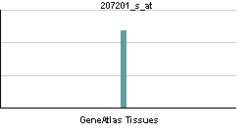SLC22A1
Solute carrier family 22 member 1 is a protein that in humans is encoded by the SLC22A1 gene.[1][2]
Polyspecific organic cation transporters in the liver, kidney, intestine, and other organs are critical for elimination of many endogenous small organic cations as well as a wide array of drugs and environmental toxins. This gene is one of three similar cation transporter genes located in a cluster on chromosome 6. The encoded protein contains twelve putative transmembrane domains and is a plasma integral membrane protein. Two transcript variants encoding two different isoforms have been found for this gene, but only the longer variant encodes a functional transporter.[2]
See also
References
- ↑ Koehler MR, Wissinger B, Gorboulev V, Koepsell H, Schmid M (Jun 1998). "The two human organic cation transporter genes SLC22A1 and SLC22A2 are located on chromosome 6q26". Cytogenet Cell Genet 79 (3–4): 198–200. doi:10.1159/000134720. PMID 9605850.
- ↑ 2.0 2.1 "Entrez Gene: SLC22A1 solute carrier family 22 (organic cation transporter), member 1".
Further reading
- Berkhout B, Jeang KT (1992). "Functional roles for the TATA promoter and enhancers in basal and Tat-induced expression of the human immunodeficiency virus type 1 long terminal repeat". J. Virol. 66 (1): 139–49. PMC 238269. PMID 1727476.
- Jeang KT; Chun R; Lin NH et al. (1993). "In vitro and in vivo binding of human immunodeficiency virus type 1 Tat protein and Sp1 transcription factor". J. Virol. 67 (10): 6224–33. PMC 238044. PMID 7690421.
- Liu YZ, Lania L, Latchman DS (1997). "Functional interaction between the HIV-1 Tat transactivator and the inhibitory domain of the Oct-2 cellular transcription factor". AIDS 10 (12): 1323–9. doi:10.1097/00002030-199610000-00003. PMID 8902060.
- Liu YZ, Latchman DS (1997). "The octamer-binding proteins Oct-1 and Oct-2 repress the HIV long terminal repeat promoter and its transactivation by Tat". Biochem. J. 322 ( Pt 1) (Pt 1): 155–8. PMC 1218171. PMID 9078256.
- Zhang L; Dresser MJ; Gray AT et al. (1997). "Cloning and functional expression of a human liver organic cation transporter". Mol. Pharmacol. 51 (6): 913–21. PMID 9187257.
- Gorboulev V; Ulzheimer JC; Akhoundova A et al. (1997). "Cloning and characterization of two human polyspecific organic cation transporters". DNA Cell Biol. 16 (7): 871–81. doi:10.1089/dna.1997.16.871. PMID 9260930.
- Verhaagh S, Schweifer N, Barlow DP, Zwart R (1999). "Cloning of the mouse and human solute carrier 22a3 (Slc22a3/SLC22A3) identifies a conserved cluster of three organic cation transporters on mouse chromosome 17 and human 6q26-q27". Genomics 55 (2): 209–18. doi:10.1006/geno.1998.5639. PMID 9933568.
- Chasman D, Cepek K, Sharp PA, Pabo CO (1999). "Crystal structure of an OCA-B peptide bound to an Oct-1 POU domain/octamer DNA complex: specific recognition of a protein-DNA interface". Genes Dev. 13 (20): 2650–7. doi:10.1101/gad.13.20.2650. PMC 317104. PMID 10541551.
- Tomilin A; Reményi A; Lins K et al. (2001). "Synergism with the coactivator OBF-1 (OCA-B, BOB-1) is mediated by a specific POU dimer configuration". Cell 103 (6): 853–64. doi:10.1016/S0092-8674(00)00189-6. PMID 11136971.
- Hayer M, Bönisch H, Brüss M (2001). "Molecular cloning, functional characterization and genomic organization of four alternatively spliced isoforms of the human organic cation transporter 1 (hOCT1/SLC22A1)". Ann. Hum. Genet. 63 (Pt 6): 473–82. doi:10.1017/S0003480099007770. PMID 11388889.
- Pietig G; Mehrens T; Hirsch JR et al. (2001). "Properties and regulation of organic cation transport in freshly isolated human proximal tubules". J. Biol. Chem. 276 (36): 33741–6. doi:10.1074/jbc.M104617200. PMID 11447227.
- Pan H; Qin WX; Huo KK et al. (2001). "Cloning, mapping, and characterization of a human homologue of the yeast longevity assurance gene LAG1". Genomics 77 (1–2): 58–64. doi:10.1006/geno.2001.6614. PMID 11543633.
- Xu XR; Huang J; Xu ZG et al. (2002). "Insight into hepatocellular carcinogenesis at transcriptome level by comparing gene expression profiles of hepatocellular carcinoma with those of corresponding noncancerous liver". Proc. Natl. Acad. Sci. U.S.A. 98 (26): 15089–94. doi:10.1073/pnas.241522398. PMC 64988. PMID 11752456.
- Schinkel AH, Jonker JW (2003). "Polymorphisms affecting function of the human organic cation transporter hOCT1 (SLC22A1): what are the consequences?". Pharmacogenetics 12 (8): 589–90. doi:10.1097/00008571-200211000-00001. PMID 12439217.
- Kerb R; Brinkmann U; Chatskaia N et al. (2003). "Identification of genetic variations of the human organic cation transporter hOCT1 and their functional consequences". Pharmacogenetics 12 (8): 591–5. doi:10.1097/00008571-200211000-00002. PMID 12439218.
- Schaffer A; Kim EC; Wu X et al. (2003). "Selective inhibition of class switching to IgG and IgE by recruitment of the HoxC4 and Oct-1 homeodomain proteins and Ku70/Ku86 to newly identified ATTT cis-elements". J. Biol. Chem. 278 (25): 23141–50. doi:10.1074/jbc.M212952200. PMID 12672812.
- Shu Y; Leabman MK; Feng B et al. (2003). "Evolutionary conservation predicts function of variants of the human organic cation transporter, OCT1". Proc. Natl. Acad. Sci. U.S.A. 100 (10): 5902–7. doi:10.1073/pnas.0730858100. PMC 156299. PMID 12719534.
- Sakata T; Anzai N; Shin HJ et al. (2004). "Novel single nucleotide polymorphisms of organic cation transporter 1 (SLC22A1) affecting transport functions". Biochem. Biophys. Res. Commun. 313 (3): 789–93. doi:10.1016/j.bbrc.2003.11.175. PMID 14697261.
- Bottalico B; Larsson I; Brodszki J et al. (2004). "Norepinephrine transporter (NET), serotonin transporter (SERT), vesicular monoamine transporter (VMAT2) and organic cation transporters (OCT1, 2 and EMT) in human placenta from pre-eclamptic and normotensive pregnancies". Placenta 25 (6): 518–29. doi:10.1016/j.placenta.2003.10.017. PMID 15135235.
This article incorporates text from the United States National Library of Medicine, which is in the public domain.
| ||||||||||||||||||||||||||||||||||||||||||||||||||||||||||||||||||||||||||||||||||||||||||||||||||||||||||||||||||||||||||||||||||||||||||||||||||||||||||||||||||||||||||||||||||||||||||||||||||||||||||||||||||||||||||||||||||||||||||||||||||||||||||||||||||||||||||||||||||||||||||
